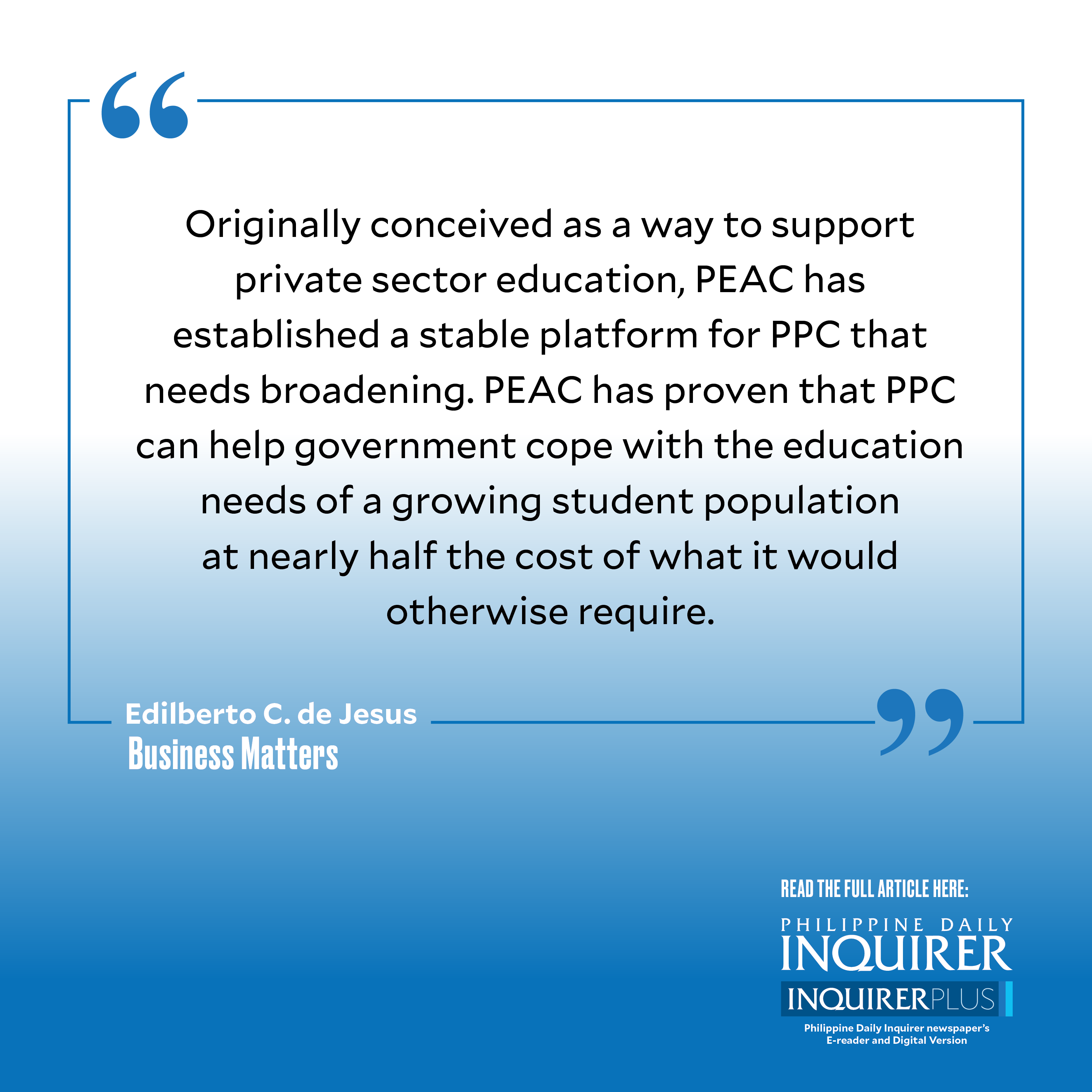More public-private education complementarity

Private Education Assistance Committee (PEAC) celebrates next month the 55th anniversary of its founding. PEAC’s history illustrates the challenge of achieving private-public complementarity (PPC) that everyone espouses but remains a work in progress. That it even survived a grueling five-year gestation period was a minor miracle, “midwifed” by Jesuit priests John W. McCarron, Thomas Fitzpatrick, and Pacifico Ortiz.
Private schools had sustained heavy losses during the war. In 1963, with John F. Kennedy, the first Catholic president, in the White House, the Jesuits thought to tap their American connections for a share of the war damage fund established by the United States. Through the Coordinating Council of Private Educational Associations of the Philippines, they could help organize the private schools to lobby for the funds and plan their use for rebuilding their facilities and faculties. The US welcomed the idea but would give the private sector only half of the $40 million that might go to education.
The proposed Fund for Assistance to Private Education (FAPE) also needed the approval of Philippine authorities, which proved more difficult to get from a government also direly needing additional resources. The Jesuits reduced their target — from $20 million to $14 million then to $10 million. But Diosdado Macapagal wanted everything committed to education for agrarian reform. The next administration’s education officials, Secretary Carlos P. Romulo and Undersecretary OD Corpus, proved more sympathetic to the private schools but also sought control of the funds — a perennial issue in PPC.
Article continues after this advertisementWith American support for the private sector stand, Ferdinand Marcos Sr. approved in 1968 the establishment of FAPE, with PEAC as trustee and executing agency. But FAPE got only $6.154 million of the $10 million it expected. The amount of $3.5 million went toward the support of the Cultural Center of the Philippines. History is silent on the disposition of the balance.
Underweight at birth, PEAC became by the ‘80s the broadest PPC platform. The Educational Service Contracting (ESC) program was the key innovation that PEAC piloted in 1982 and subsequently managed. Through the ESC, government bought empty seats in private high schools for students that could not find space in public schools. PEAC’s task included evaluating the private school partners to ensure compliance with government standards, monitoring the attendance of their ESC students, and settling their payments.
Following the passage of the 1989 law on Government Assistance to Private Students and Teachers of Private Education (GASTPE), the education department took over the management of ESC in 1991. The tasks proved more difficult than presumed and reverted to PEAC in 1996. PEAC also received funds to provide in-service training for teachers (1998) and the authority to conduct a program to certify private schools wishing to join ESC (2004).
Article continues after this advertisementThe planned shift to K-12 in 2013 again caught the Department of Education (DepEd) with an inadequate supply of seats for the expected student demand. Again, PEAC and the private sector moved to meet the shortage — through a Senior High School Voucher Program (SHS VP). Since PEAC was already managing the ESC supply chain between public and private schools for K7-10, it was logical to give it the mandate to run the SHS VP for K-11 and K-12.
In school year 2021-2022, the ESC program covered 973,000 students at the cost of P934 billion. The SHS VP qualified about 26,000 students to use its vouchers. Subsidies provided by these PEAC programs enabled tuition-charging private schools to generate income from available classroom seats left vacant by competition from tuition-free public schools.
Private schools undoubtedly benefited from the PEAC programs. The benefits to government were at least as great. Government could not have implemented K-12 without the private schools, which absorbed some 40 percent of the first SHS cohort. The SHS VP and the ESC helped poor families send their children for secondary education. FAPE/PEAC helped address the shortage of schools in the public education system that the requested P15.6 billion budget for 6,000 classrooms in 2023 would hopefully alleviate.
Originally conceived as a way to support private sector education, PEAC has established a stable platform for PPC that needs broadening. PEAC has proven that PPC can help government cope with the education needs of a growing student population at nearly half the cost of what it would otherwise require. The congressional decision to allocate P150 million for GASTPE, rather than for DepEd confidential funds, is a good start.
* * *
Edilberto C. de Jesus is professor emeritus at the Asian Institute of Management.
Business Matters is a project of the Makati Business Club ([email protected]).















